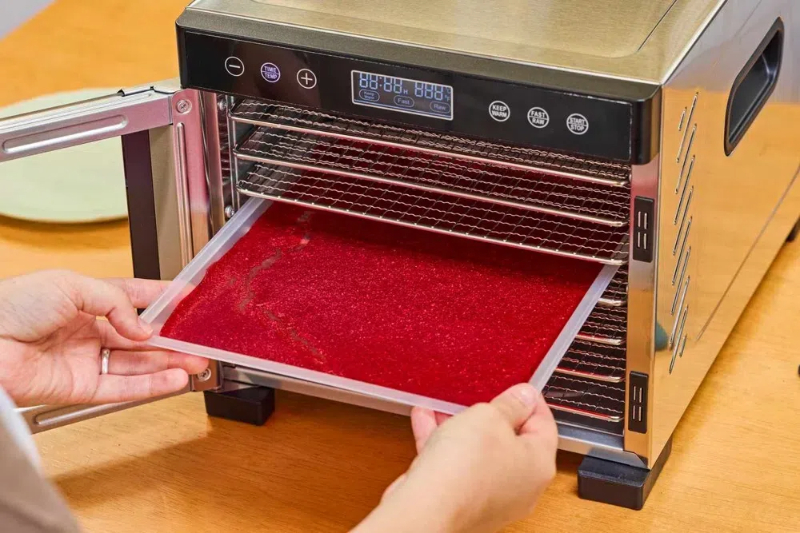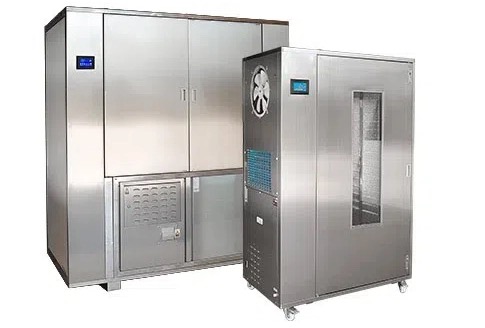
Content Menu
● Introduction
● What is a Cabinet Type Dehydrator?
● Benefits of Using Cabinet Type Dehydrators
● Environmental Impact: A Detailed Analysis
>> Energy Consumption
>> Food Waste Reduction
● Comparison with Other Preservation Methods
● Use of Materials
● Mitigating Negative Impacts
● The Role of Dehydration in Sustainable Agriculture
● Life Cycle Assessment of Cabinet Dehydrators
● Future Trends and Innovations
● Conclusion
● FAQ
>> 1. What are the Main Benefits of Using a Cabinet Dehydrator?
>> 2. How Energy Efficient are Cabinet Dehydrators Compared to Other Methods?
>> 3. Can Cabinet Dehydrators Help Reduce Food Waste?
>> 4. What Materials are Used in Cabinet Dehydrators, and Are They Sustainable?
>> 5. How Can I Mitigate the Environmental Impact of Using a Cabinet Dehydrator?
● Citations:
Introduction
In an era increasingly defined by environmental consciousness, the food industry is under immense pressure to adopt sustainable practices. Food preservation, a critical aspect of the food supply chain, is no exception. Traditional methods of food preservation, such as canning and freezing, often involve significant energy consumption and can have substantial environmental footprints. Dehydration, particularly using cabinet-type dehydrators, presents a compelling alternative. This article delves into the environmental impact of using cabinet-type dehydrators, exploring their benefits, drawbacks, and overall sustainability.

What is a Cabinet Type Dehydrator?
A cabinet dehydrator is a device designed to remove moisture from food items, thereby preserving them for extended periods. It operates on the principle of forced convection, utilizing a heating element and a fan to circulate warm air evenly across trays loaded with food. The precise control over temperature and humidity allows for optimal drying conditions, which are crucial for maintaining the flavor, texture, and nutritional content of the dehydrated food.
Key components of a cabinet dehydrator:
- Insulated Cabinet: Constructed to minimize heat loss and ensure efficient operation.
- Trays/Racks: Typically made from food-grade materials like stainless steel or BPA-free plastic, providing a hygienic surface for drying.
- Heating Element: Provides a consistent heat source to warm the air inside the cabinet.
- Fan: Circulates air evenly to ensure uniform drying.
- Temperature and Humidity Controls: Allows for precise adjustment of drying conditions.
- Air Vents: Regulate airflow and moisture removal.
Cabinet dehydrators are versatile and can be used in homes, commercial food processing facilities, restaurants, and even pharmaceutical and cosmetic industries. They can dry a wide range of foods, including fruits, vegetables, meats, herbs, and spices.
Benefits of Using Cabinet Type Dehydrators
Cabinet dehydrators offer numerous advantages over other drying methods, making them a popular choice for sustainable food preservation.
- Extended Shelf Life: Dehydration significantly extends the shelf life of perishable foods, reducing waste and ensuring a readily available supply of essential nutrients.
- Preservation of Nutrients: Retains a high percentage of vitamins and minerals, ensuring nutritional value is preserved during the drying process.
- Utilization of Surplus: Allows for the preservation of excess produce from gardens or farms, preventing food from going to waste and maximizing resources.
- Versatility: Can dry a wide range of foods, including fruits, vegetables, meats, and herbs.
- Energy Efficiency: Designed with insulated cabinets and precise temperature controls to minimize energy consumption.
- Food Safety: Removes moisture, which inhibits the growth of bacteria, mold, and other microorganisms.
Environmental Impact: A Detailed Analysis
Energy Consumption
One of the primary environmental concerns associated with any electrical appliance is its energy consumption. Cabinet dehydrators, while generally energy-efficient, do require electricity to operate. The amount of energy consumed depends on several factors:
- Model and Size: Larger dehydrators typically consume more energy.
- Insulation: Well-insulated dehydrators minimize heat loss, reducing energy consumption.
- Drying Time: Longer drying times naturally result in higher energy usage.
- Temperature Settings: Higher temperatures require more energy to maintain.
- Efficiency of Components: High-efficiency heating elements and fans contribute to energy savings.
Modern cabinet dehydrators are designed with energy efficiency in mind. Features such as insulated walls and doors, efficient heating and cooling components, and advanced control systems help optimize energy consumption. Some models can even be powered by solar energy, further reducing their environmental impact.
Food Waste Reduction
Food waste is a significant global issue with far-reaching environmental and economic consequences. It is estimated that approximately one-third of the food produced globally is lost or wasted. This waste contributes to greenhouse gas emissions, water and land usage, and economic losses.
Cabinet dehydrators can play a crucial role in reducing food waste by preserving excess food that would otherwise spoil. By dehydrating fruits, vegetables, and meats before they go bad, their shelf life can be extended, and the amount of food that ends up in the trash can be reduced. For example, overripe bananas can be dehydrated into banana chips, and surplus tomatoes can be transformed into sun-dried tomatoes.
Reducing food waste not only saves money but also helps promote sustainability. Businesses can reduce their waste disposal costs and minimize their environmental impact by dehydrating excess produce. Consumers can also save money and reduce their carbon footprint by dehydrating food that would otherwise go to waste.

Comparison with Other Preservation Methods
To fully understand the environmental impact of cabinet dehydrators, it is essential to compare them with other common food preservation methods, such as canning and freezing.
Canning:
- Energy Consumption: Canning involves heating food to high temperatures to kill microorganisms, which requires significant energy. Additionally, the production of cans themselves is an energy-intensive process.
- Resource Use: Canning requires a substantial amount of water for processing and cleaning. The production of cans also involves the extraction and processing of raw materials like aluminum or steel.
- Waste Generation: Disposing of used cans can contribute to landfill waste, although recycling can mitigate this impact.
Freezing:
- Energy Consumption: Freezing requires maintaining food at very low temperatures, which consumes a significant amount of electricity. Freezers also need to be defrosted periodically, which further increases energy usage.
- Resource Use: Freezing requires plastic bags or containers, which are typically made from petroleum-based materials.
- Waste Generation: While frozen food can last for a long time, it can still spoil if not stored properly or if the freezer malfunctions. Disposing of spoiled frozen food contributes to food waste.
In comparison, cabinet dehydrators generally consume less energy than canning and freezing, especially when considering the long-term storage of food. They also produce less waste, as dehydrated food can be stored in airtight containers or vacuum-sealed bags, which can be reused.
Use of Materials
The materials used to construct cabinet dehydrators also have an environmental impact. Most cabinet dehydrators are made from stainless steel, which is easy to clean and sanitize. Stainless steel is non-porous, making it difficult for bacteria to adhere to the surface. However, the production of stainless steel is energy-intensive and can result in pollution.
Some cabinet dehydrators also use plastic components, such as trays and control panels. While plastic is lightweight and durable, it is also derived from petroleum and can contribute to plastic waste. Choosing dehydrators with BPA-free plastic can reduce the risk of harmful chemicals leaching into food.
Mitigating Negative Impacts
While cabinet dehydrators offer numerous environmental benefits, it is essential to take steps to mitigate their potential negative impacts.
- Choose Energy-Efficient Models: Look for dehydrators with insulated cabinets, efficient heating elements, and advanced control systems.
- Use Solar Power: Opt for models that can be powered by solar energy.
- Reduce Drying Time: Slice food thinly to reduce drying time and energy consumption.
- Maintain Proper Ventilation: Ensure proper ventilation to facilitate efficient moisture removal.
- Clean Regularly: Keep the dehydrator clean to ensure efficient operation and prevent contamination.
- Reuse Packaging: Store dehydrated food in reusable containers or vacuum-sealed bags.
The Role of Dehydration in Sustainable Agriculture
Sustainable agriculture aims to minimize environmental impact while ensuring food security and economic viability. Dehydration, particularly using cabinet-type dehydrators, can play a crucial role in supporting sustainable agricultural practices.
Reducing Post-Harvest Losses: A significant portion of agricultural produce is lost after harvest due to spoilage and decay. Dehydration can help reduce these losses by preserving surplus produce that would otherwise go to waste. This is especially important for small-scale farmers in developing countries, who may lack access to refrigeration or other preservation technologies.
Promoting Crop Diversification: Dehydration can encourage farmers to diversify their crops by providing a way to preserve and market a wider range of produce. For example, farmers can dehydrate fruits and vegetables that are not in high demand during certain times of the year, creating new income opportunities and reducing reliance on a single crop.
Enhancing Food Security: By preserving food for extended periods, dehydration can enhance food security, especially in regions prone to drought or other natural disasters. Dehydrated food can be stored and consumed during times of scarcity, ensuring a stable food supply.
Reducing Transportation Costs: Dehydrated food is lighter and more compact than fresh food, which can reduce transportation costs and greenhouse gas emissions. This is especially important for food that is transported over long distances.
Life Cycle Assessment of Cabinet Dehydrators
A life cycle assessment (LCA) is a comprehensive method for evaluating the environmental impacts of a product or service throughout its entire life cycle, from raw material extraction to disposal. Conducting an LCA of cabinet dehydrators can provide valuable insights into their overall sustainability.
Raw Material Extraction: The extraction of raw materials, such as stainless steel and plastic, can have significant environmental impacts, including habitat destruction, water pollution, and greenhouse gas emissions. Choosing dehydrators made from recycled materials or with a lower material footprint can help reduce these impacts.
Manufacturing: The manufacturing process also requires energy and resources and can generate pollution. Optimizing manufacturing processes and using renewable energy sources can help reduce the environmental impacts of dehydrator production.
Distribution: The distribution of cabinet dehydrators involves transportation, which can contribute to greenhouse gas emissions. Choosing dehydrators that are manufactured locally or using more efficient transportation methods can help reduce these emissions.
Use Phase: The use phase is where the majority of energy consumption occurs. As discussed earlier, choosing energy-efficient models and adopting best practices for operation can help minimize energy usage.
End-of-Life: At the end of their useful life, cabinet dehydrators can be recycled or disposed of in landfills. Recycling materials like stainless steel can help reduce the need for raw material extraction and conserve resources.
Future Trends and Innovations
The field of food dehydration is constantly evolving, with new technologies and innovations emerging that promise to further enhance the sustainability of cabinet-type dehydrators.
Improved Energy Efficiency: Future dehydrators are likely to incorporate even more energy-efficient components and designs, such as advanced insulation materials, variable-speed fans, and smart control systems that optimize energy consumption based on the type of food being dried.
Solar-Powered Dehydration: Solar-powered dehydrators are becoming increasingly popular, especially in off-grid or rural areas. Future models may integrate more efficient solar panels and energy storage systems, making them even more sustainable and accessible.
Biomaterial Construction: Some manufacturers are exploring the use of biomaterials, such as plant-based plastics and composite materials, to construct dehydrators. These materials can reduce reliance on petroleum-based plastics and lower the overall environmental footprint of the dehydrator.
Smart Dehydration Systems: Smart dehydrators with integrated sensors and connectivity can monitor temperature, humidity, and moisture content in real-time, automatically adjusting drying parameters to optimize energy efficiency and food quality.
Hybrid Drying Technologies: Combining cabinet dehydration with other drying technologies, such as microwave or infrared drying, can further reduce drying time and energy consumption.
Conclusion
Cabinet-type dehydrators represent a significant advancement in sustainable food preservation. Their ability to efficiently remove moisture while retaining nutritional value makes them an indispensable tool for reducing food waste and promoting self-sufficiency. Whether for home use, commercial operations, or agricultural purposes, cabinet dehydrators offer a versatile and eco-friendly solution for preserving food and ensuring a more sustainable future. By adopting this technology and taking steps to mitigate potential negative impacts, we can contribute to a more resilient and environmentally responsible food system.

FAQ
1. What are the Main Benefits of Using a Cabinet Dehydrator?
Cabinet dehydrators offer extended shelf life for foods, preservation of nutrients, efficient utilization of surplus produce, and are versatile for various food types. They also tend to be energy-efficient and enhance food safety by removing moisture that inhibits microbial growth.
2. How Energy Efficient are Cabinet Dehydrators Compared to Other Methods?
Cabinet dehydrators are generally more energy-efficient than canning and freezing, especially for long-term storage, and produce less waste. They often feature insulated designs and precise temperature controls to minimize energy consumption.
3. Can Cabinet Dehydrators Help Reduce Food Waste?
Yes, cabinet dehydrators play a crucial role in reducing food waste by preserving excess food that would otherwise spoil. They extend the shelf life of fruits, vegetables, and meats, reducing the amount of food that ends up in the trash.
4. What Materials are Used in Cabinet Dehydrators, and Are They Sustainable?
Most cabinet dehydrators use stainless steel for its ease of cleaning and sanitation. While durable, its production is energy-intensive. Some models also use plastics, so choosing BPA-free options can reduce chemical risks.
5. How Can I Mitigate the Environmental Impact of Using a Cabinet Dehydrator?
To reduce environmental impact, choose energy-efficient models, consider solar-powered options, reduce drying time by slicing food thinly, ensure proper ventilation, clean the dehydrator regularly, and reuse packaging for storing dehydrated food.
Citations:
[1] https://www.dryeratech.com/sustainable-food-preservation-why-choose-a-cabinet-type-dehydrator.html
[2] https://patents.google.com/patent/CN110207480A/zh
[3] https://www.dryeratech.com/top-10-benefits-of-using-a-cabinet-type-dehydrator.html
[4] https://patents.google.com/patent/CN201919616U/zh
[5] https://www.researchgate.net/publication/274863230_Improvement_of_Efficiency_and_Environmental_Impact_of_a_Low-Cost_Food_Dehydrator
[6] https://patents.google.com/patent/CN1110593C/zh
[7] https://njccs.journals.ekb.eg/article_279497_e80cd9bd96a1bcf24de2b74650761e26.pdf
[8] https://patents.google.com/patent/CN109252340A/zh











